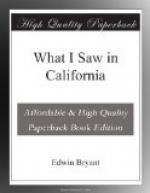“The Indians are naturally filthy and careless, and their understanding is very limited. In the small arts they are not deficient in ideas of imitation but they never will be inventors. Their true character is that of being revengeful and timid, consequently they are very much addicted to treachery. They have no knowledge of benefits received, and ingratitude is common amongst them. The education they receive in their infancy is not the proper one to develope their reason, and, if it were, I do not believe them capable of any good impression. All these Indians, whether from the continual use of the sweat-house, or from their filthiness, or the little ventilation in their habitations, are weak and unvigorous; spasms and rheumatics, to which they are so much subject, are the consequences of their customs. But what most injures them, and prevents propagation, is the venereal disease, which most of them have very strongly, clearly proving that their humours are analogous to receiving the impressions of this contagion. From this reason may be deduced the enormous differences between the births and deaths, which, without doubt, is one-tenth per year in favour of the latter; but the missionaries do all in their power to prevent this, with respect to the catechumens situated near them.
“The general productions of the missions are, the breed of the larger class of cattle, and sheep, horses, wheat, maize or Indian corn, beans, peas, and other vegetables; though the productions of the missions situated more to the southward are more extensive, these producing the grape and olive in abundance. Of all these articles of production, the most lucrative is the large cattle, their hides and tallow affording an active commerce with foreign vessels on this coast. This being the only means the inhabitants, missionaries, or private individuals have of supplying their actual necessities, for this reason they give this branch all the impulse they possibly can, and on it generally place all their attention.




